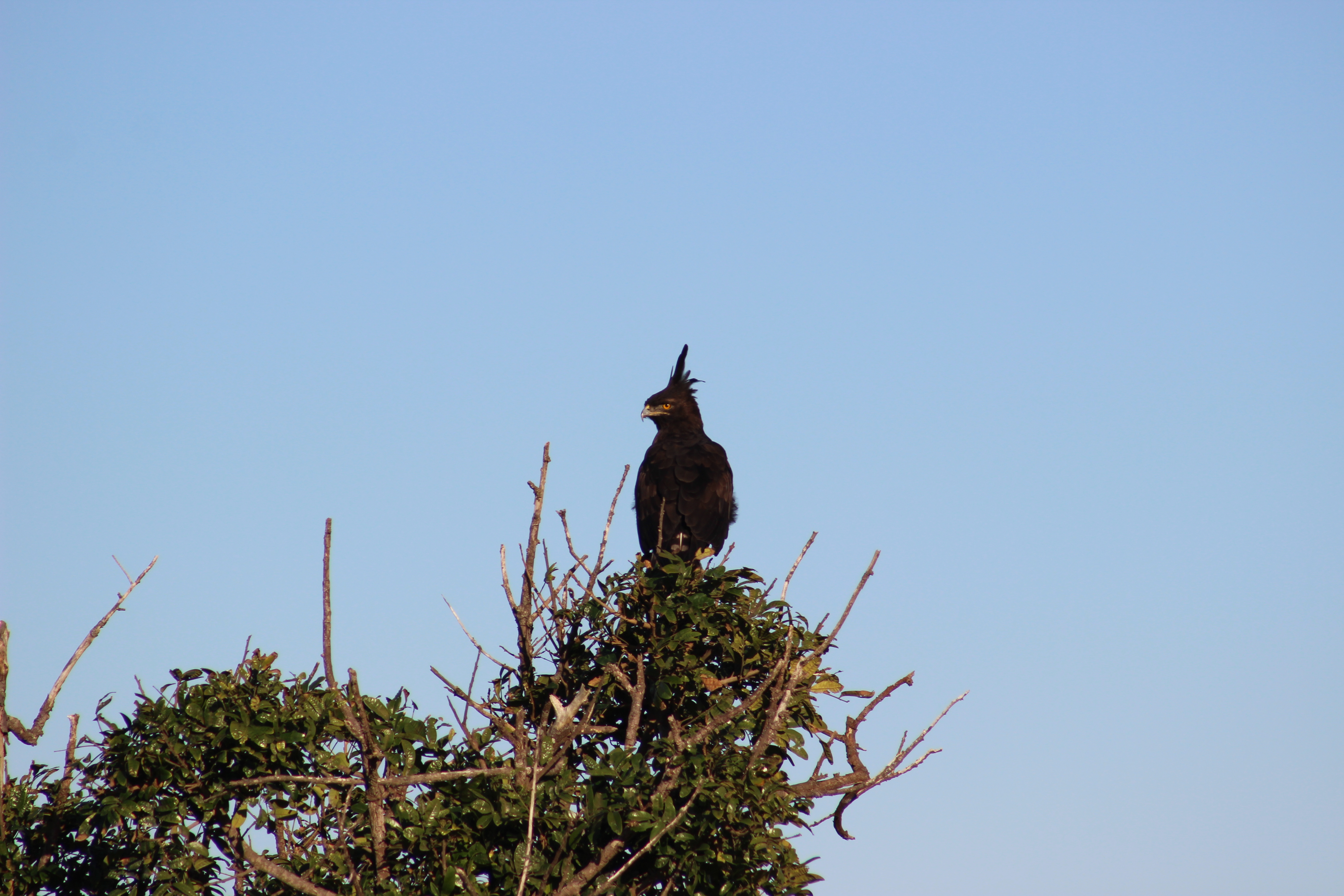Long-crested Eagle (Lophaetus occipitalis)
CAR summary data
Habitat and noted behaviour
Sightings per Kilometre
Please note: The below charts indicate the sightings of individuals along routes where the species has occured, and NOT across all routes surveyed through the CAR project.
Global Status

IUCN Data (Global)
IUCN 2024. IUCN Red List of Threatened Species. Version 2024-1 (www)Assessment year: 2025
Assessment Citation
BirdLife International 2025. Lophaetus occipitalis. The IUCN Red List of Threatened Species 2025: e.T22696134A281488645. Accessed on 09 December 2025.Geographic range:
Occurs in sub-Saharan Africa, ranging south from southern Mauritania, Senegambia, central Mali, Burkina Faso, southern Niger, central Chad, Sudan, northern Ethiopia, and north-western Somalia, extending southwards to western and northern Angola, north-eastern Namibia, northern Botswana, Zimbabwe, Mozambique, and eastern and south-eastern South Africa (Ferguson and Christie 2001).Habitats:
Occupies woodland, forest edge, damp wooded savannah, and strips of riverine forest, particularly where short marshy grassland is present and suitable lookout perches are available (Ferguson-Lees and Christie 2001). The species is highly adaptable and is often most abundant in areas where woodland has been partially cleared for agriculture, including near villages and within exotic plantations such as eucalyptus and pine. It also readily uses small-scale cultivated landscapes (Ferguson-Lees and Christie 2001). Vagrant individuals may occur in more open grassland, frequently along roadsides, and may remain for several days in recently burned areas. It is predominantly found from sea level up to 2,000 m, but occurs at elevations reaching 3,000 m (Ferguson-Lees and Christie 2001).Population:
The species is locally common but exhibits a patchy distribution, which complicates efforts to estimate its total population size. An estimate of approximately 200 pairs in north-eastern South Africa corresponds to a low density of around one pair per 650 km2 (Ferguson-Lees and Christie 2001). However, densities may be substantially higher in more humid regions, where home ranges have been estimated at just 20–30 km2. The species is often absent from apparently suitable habitat, likely due to insufficient prey. Nevertheless, given its extensive range, the global population is likely to number in the upper tens of thousands of mature individuals (Ferguson-Lees and Christie 2001).Threats:
Electrocution and collisions with power infrastructure pose an increasing threat to the species. It is a sit and wait raptor and may perch on power lines whilst searching for prey. This species has a high distribution within high-risk electrocution areas, covering approximately 6,777 km2 in Kenya (Ngila et al. 2024), and is considered highly susceptible to electrocution due to hazardous power pole designs introduced during the expansion of the Rural Electrification Programme through key raptor habitats, including protected areas (Ogada et al. 2022).While the species benefits from moderate tree clearing and agricultural expansion that create open habitats, it remains vulnerable to extensive loss of woodlands and wetlands. The species partially compensates by using exotic plantations, small agricultural clearings, and secondary forests (Kemp et al. 2020).
Another possible threat is from trade, as the species has been recorded in five of the seven trade datasets evaluated (Donald et al. 2024). However, the origin, end use and number of individuals involved, and the overall scale of this trade remain unknown.
Conservation measures:
Conservation Action underwayThe species is listed on CITES Appendix II (CITES Trade Database 2025).
Conservation Actions and Research Proposed
Promote and implement wildlife-friendly agricultural practices that ensure the retention and connectivity of natural habitat patches within agricultural landscapes. Develop and enforce guidelines for power infrastructure design and placement to reduce electrocution risk, including the adoption of bird-safe pole designs in key raptor habitats. Conduct systematic surveys across the species’ range to estimate population size and assess population trends with robust quantitative data. Investigate how populations respond to varying degrees of agricultural expansion and habitat modification, to clarify the balance between beneficial and detrimental effects. Assess the impact of hunting and trapping for trade on local populations, including quantifying trade volumes and geographic sources. Monitor mortality from electrocution and collision with power infrastructure to understand the scale of this threat.
Rationale:
This species has an extremely large range, and hence does not approach the thresholds for Vulnerable under the range size criterion (extent of occurrence <20,000 km2 combined with a declining or fluctuating range size, habitat extent/quality, or population size and a small number of locations or severe fragmentation). The population trend appears to be stable, and hence the species does not approach the thresholds for Vulnerable under the population trend criterion (>30% decline over ten years or three generations). The population size has not been quantified, but it is not believed to approach the thresholds for Vulnerable under the population size criterion (<10,000 mature individuals with a continuing decline estimated to be >10% in ten years or three generations, or with a specified population structure). For these reasons the species is evaluated as Least Concern.Trend justification:
Atlas data comparing SABAP1 (1987–1991) and SABAP2 (2007–2019) show that reporting rates for this species increased in 13% of South African grid cells, including 8.5% where the species had not previously been recorded during SABAP1 (Maphalala 2019). Only 4.6% of grid cells showed declines, indicating an overall increase in relative abundance and a westward range expansion. This trend is partly attributed to cropland expansion, which increases prey availability for this species. However, these benefits are contingent on the retention of natural habitat patches which provide essential nesting, roosting, and foraging sites (Maphalala 2019), though it can nest in exotic eucalyptus (Monadjem and Rasmussen 2008). The species shows a strong preference for heterogeneous agricultural landscapes, particularly along field edges that retain natural vegetation and hunting perches (Maphalala 2019). Where agricultural intensification results in widespread habitat loss and structural simplification, localised population declines are likely to occur.In Kenya, long-term road transect data recorded a 95% decline in encounter rates outside of protected areas and a 490% increase within protected areas between 1970–1977 and 2003–2020, with an overall reduction of 80% over three generations (Ogada et al. 2022). However, despite the magnitude of this reported decline, eBird (2025) data from the past decade indicate that the species remains commonly recorded and widespread across its range within the country; as such, these findings should be interpreted with caution.
sRedList (2025) estimates a 7.7% decline in tree cover within the species’ range between 2000 and 2022. Given the species’ broad distribution and ecological flexibility, this moderate rate of habitat loss is unlikely to drive declines and may even create opportunities by opening habitats favourable to the species.
Across sub-Saharan Africa, the species is broadly distributed and remains common in many regions (eBird 2025). Populations are possibly increasing in areas where agricultural expansion is moderate and accompanied by the retention of natural vegetation. Although localised declines may occur in the most intensively farmed or otherwise highly degraded landscapes, the species’ adaptability enables persistence across a range of habitats, including human-modified habitats (Ferguson-Lees and Christie 2001). Additionally, as a rodent eating species it is regarded locally as beneficial and therefore is little persecuted (Ferguson-Lees and Christie 2001).
The species is considered stable at the global scale, with declines likely restricted to areas experiencing severe habitat transformation that exceed its capacity to adapt to. However, due to limited data across much of the species’ range, and contrasting trends where data are available (Maphalala 2019, Ogada et al. 2022), further work is needed to clarify population trends across its global range.
 Login
Login



